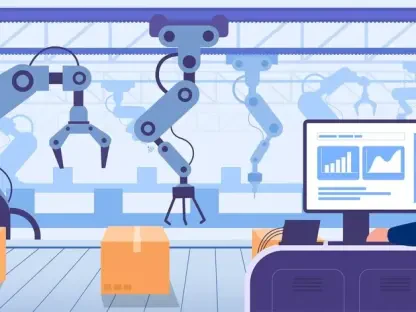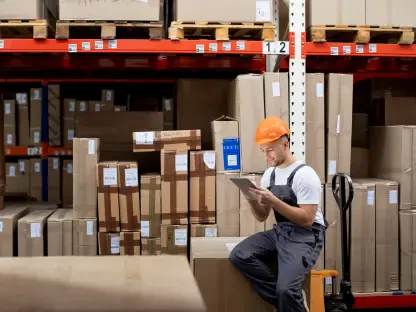The logistics and sourcing industry is undergoing significant transformation thanks to advancements in artificial intelligence (AI), automation, data analytics, and other emerging technologies. Businesses are seeking smarter ways to optimize their supply chains to stay competitive in the global market. These innovative technologies are reshaping logistics by enhancing efficiency, reducing risks, and streamlining operations.
AI Transforming Logistics and Sourcing
Real-Time Data Analysis and Predictive Insights
AI enables real-time data analysis and provides predictive insights, revolutionizing logistics and sourcing. These capabilities allow businesses to make informed decisions that enhance operational efficiency and minimize risks. With real-time data analysis, companies can monitor their supply chains continuously, identifying potential bottlenecks and addressing them before they escalate into significant disruptions. This dynamic approach ensures that businesses remain agile and responsive to the ever-changing market conditions.
In addition, predictive insights generated by AI are invaluable for future planning. By analyzing historical data and identifying trends, AI can forecast demand more accurately. This predictive capability mitigates the risks of overstocking or understocking, ensuring that businesses maintain optimal inventory levels. Consequently, this reduces unnecessary expenses and enhances customer satisfaction by ensuring products are available when needed.
Key AI Applications
AI applications in logistics and sourcing extend beyond real-time data analysis and predictive insights. Predictive analytics is a notable application, as it allows for more accurate demand forecasting. By leveraging advanced algorithms, AI can analyze vast amounts of data to project future market demands, preventing costly inventory shortages and minimizing excess stock. This level of precision is crucial for businesses seeking to optimize their inventory management.
Supplier risk assessments represent another critical application of AI. By evaluating supplier performance through AI-driven algorithms, businesses can identify potential risks and disruptions before they occur. This proactive approach helps mitigate supply chain disruptions by enabling companies to address issues with suppliers swiftly, ensuring a stable and reliable supply chain. Additionally, dynamic pricing models powered by AI continuously analyze market trends, allowing businesses to adjust pricing strategies accordingly. This capability optimizes procurement costs, offering a competitive edge in the marketplace.
Automation in Procurement and Sourcing
Streamlining Procurement Processes
Automation is revolutionizing procurement and sourcing by significantly reducing manual intervention and enhancing operational efficiency. AI-powered platforms have become instrumental in streamlining procurement processes. By automating repetitive and time-consuming tasks, businesses can allocate resources more effectively, focusing on strategic initiatives rather than routine operations. This shift not only improves overall productivity but also reduces the likelihood of human error, ensuring more accurate and reliable procurement practices.
Moreover, automation enhances supplier collaboration by simplifying communication and coordination. Automated systems facilitate seamless information sharing between businesses and suppliers, improving transparency and fostering stronger relationships. This level of integration allows for quicker responses to market changes and ensures that procurement processes are agile and adaptable. As a result, businesses can achieve faster turnaround times and improved efficiency in sourcing materials and products.
Trends in Automation
Several key trends are shaping the automation landscape in procurement and sourcing. Supplier matching algorithms, for instance, leverage AI to connect businesses with the most suitable suppliers based on criteria such as cost, quality, and delivery performance. These algorithms enable businesses to make data-driven decisions, ensuring they partner with suppliers that align with their strategic objectives.
Automated negotiations are another significant trend. AI tools can carry out price negotiations on behalf of procurement teams, facilitating faster and more efficient deal-making. This automation speeds up the procurement process, allowing businesses to secure favorable terms and conditions swiftly.
Procurement chatbots further exemplify the trends in automation. These AI-powered bots handle supplier inquiries, order placements, and inventory tracking, freeing up procurement teams to focus on more strategic tasks. By providing instant responses and automating routine tasks, chatbots enhance the overall efficiency of the procurement process.
Real-time performance monitoring of suppliers is also becoming increasingly prevalent. AI continuously assesses supplier performance, ensuring quality control and compliance throughout the sourcing process. This capability helps businesses maintain high standards and promptly address any issues that may arise, ultimately strengthening the supply chain.
The Rise of Smart Warehousing
Innovations in Smart Warehousing
Smart warehouses are becoming essential in modern logistics operations as the demand for speed and efficiency continues to grow. Powered by AI, robotics, and the Internet of Things (IoT), these facilities revolutionize the storage and distribution of goods. The integration of these advanced technologies creates an ecosystem where every aspect of warehouse operations is optimized for maximum efficiency.
One of the key innovations in smart warehousing is the use of autonomous mobile robots (AMRs). These robots are designed to transport goods within the warehouse efficiently, reducing the need for human labor. By automating material handling tasks, AMRs increase overall productivity and minimize the risk of human error. This automation not only speeds up operations but also allows warehouse staff to focus on more complex and value-added activities.
Smart Warehousing Technologies
AI-powered inventory management is another transformative technology in smart warehousing. By leveraging predictive analytics, AI tools can effectively manage stock levels, preventing overstocking or stockouts. These systems continuously analyze inventory data, making real-time adjustments to ensure optimal stock levels. This capability is critical for maintaining a smooth flow of operations and meeting customer demands promptly.
Augmented reality (AR) for order picking is also gaining traction in smart warehousing. Equipped with AR glasses, warehouse employees receive visual cues and instructions that guide them to the precise location of items. This technology streamlines the order-picking process, significantly reducing the time it takes to locate and retrieve products. The result is faster and more accurate order fulfillment, enhancing customer satisfaction.
Automated sorting and packaging systems further exemplify the advancements in smart warehousing. AI and robotics-driven sorting systems can process large volumes of goods with precision and speed. These systems reduce manual sorting times and improve packaging accuracy, enabling faster order fulfillment and reducing the risk of errors. As a result, businesses can achieve higher throughput and deliver products to customers more efficiently.
AI and IoT-Driven Logistics Optimization
Real-Time Insights and Smarter Decisions
Combining AI with IoT technologies significantly enhances logistics optimization by providing real-time insights into transportation and logistics operations. This fusion of advanced technologies offers a comprehensive view of the supply chain, enabling businesses to make smarter, data-driven decisions. By leveraging real-time data, companies can monitor the status of shipments, track the location of goods, and make dynamic adjustments to optimize logistics processes.
Real-time insights are invaluable for ensuring timely deliveries and improving overall logistics efficiency. By continuously analyzing data from IoT sensors and devices, businesses can identify potential delays and take proactive measures to address them. This capability enhances the reliability of logistics operations and ensures that products reach their destinations on time, meeting customer expectations.
Applications in Logistics
Several applications demonstrate the effectiveness of AI and IoT in logistics optimization. Route optimization algorithms, for instance, leverage AI to analyze real-time traffic data and determine the most efficient delivery routes. By optimizing routes, businesses can reduce fuel costs, minimize delivery times, and enhance the overall efficiency of their transportation networks. This capability is particularly valuable in complex and dynamic urban environments, where traffic conditions can change rapidly.
IoT-enabled fleet monitoring is another critical application. By equipping vehicles with IoT sensors, businesses can track the location and condition of shipments in real-time. This visibility allows for more accurate delivery estimates and ensures the safety and security of goods in transit. Additionally, IoT sensors can monitor vehicle health, providing data for AI-driven predictive maintenance. By predicting maintenance needs, businesses can prevent breakdowns and unplanned delays, ensuring a smooth flow of operations.
Autonomous delivery vehicles, including drones and self-driving trucks, represent a cutting-edge application of AI and IoT in logistics. These technologies improve last-mile delivery efficiency by reducing the time and cost associated with manual deliveries. Autonomous vehicles can navigate complex delivery environments, ensuring timely and precise deliveries. As these technologies continue to advance, they hold the potential to revolutionize the logistics industry, providing faster and more reliable delivery solutions.
Blockchain and AI for Transparent Sourcing
Unprecedented Transparency
Integrating blockchain and AI technologies brings unprecedented transparency to the sourcing process since these solutions help businesses verify product authenticity, track suppliers, and prevent fraudulent transactions. By leveraging blockchain’s immutable ledger and AI’s analytical capabilities, companies can enhance the security and reliability of their sourcing operations.
Blockchain technology ensures that procurement records are tamper-proof, making the sourcing process more secure. Each transaction is recorded on an immutable ledger, providing a transparent and unalterable history of sourcing activities. This level of transparency is crucial for verifying the authenticity of products and preventing counterfeit goods from entering the supply chain.
Secure and Transparent Sourcing
Applications of blockchain and AI extend to smart contracts, which automate compliance checks and enforce contract terms. These AI-powered contracts reduce disputes and delays by ensuring that all parties adhere to agreed-upon conditions. By automating the contract management process, businesses can minimize administrative overhead and focus on more strategic initiatives.
Counterfeit detection is another critical application. AI analyzes blockchain data to identify patterns and anomalies that may indicate counterfeit products. By leveraging AI’s analytical capabilities, businesses can detect and prevent the circulation of counterfeit goods, ensuring the integrity of their supply chains. This capability is particularly valuable in industries where product authenticity is paramount, such as pharmaceuticals and luxury goods.
Decentralized supplier networks enabled by blockchain promote transparent global trade. Businesses can collaborate with suppliers in a decentralized manner, ensuring that all parties have access to accurate and up-to-date information. This level of transparency fosters trust and collaboration, enhancing the overall efficiency and reliability of the sourcing process.
AI-Powered Risk Management in Supply Chains
Enhancing Supply Chain Resilience
As supply chains become more complex, businesses face various risks, including geopolitical instability and cyber threats. AI plays a crucial role in mitigating these risks and enhancing supply chain resilience. By leveraging AI-driven analytics, businesses can identify potential risks and develop strategies to address them proactively. This capability is essential for maintaining a stable and reliable supply chain in an increasingly volatile global environment.
AI-powered risk management systems continuously monitor global events and trade disruptions, allowing businesses to adjust their supply chain strategies in real time. This proactive approach ensures that companies can respond swiftly to potential threats, minimizing the impact of disruptions on their operations. By anticipating and addressing risks, businesses can maintain a higher level of supply chain resilience.
Risk Management Strategies
Geopolitical risk analysis is a key strategy enabled by AI. By monitoring global events and analyzing their potential impact on supply chains, AI tools provide businesses with actionable insights. This capability allows companies to navigate geopolitical uncertainties more effectively, ensuring that their supply chains remain robust and adaptable to changing conditions.
Climate risk assessment is another critical application of AI in risk management. AI models can assess environmental risks that could impact logistics operations, such as natural disasters or climate-related issues. By understanding these risks, businesses can develop contingency plans and implement measures to mitigate their impact. This proactive approach enhances the overall resilience of the supply chain.
Cybersecurity enhancements powered by AI are also vital for protecting the integrity of digital supply chains. AI-powered security systems continuously monitor for cyber threats, detecting and neutralizing potential attacks. This capability ensures that sensitive data and digital assets are protected from cyber threats, safeguarding the supply chain from disruptions caused by cyber incidents.
Supplier diversification planning is another key strategy. AI identifies alternative suppliers, reducing dependency on a single source and increasing supply chain flexibility. By diversifying their supplier base, businesses can mitigate the risks associated with supplier disruptions, ensuring a more reliable and resilient supply chain.
The Role of Sustainability in Smart Sourcing
Sustainable Practices with AI and Automation
Sustainability is increasingly becoming a priority for businesses seeking to improve their sourcing practices. AI and automation assist companies in reducing their carbon footprint, enhancing sustainability efforts, and adopting more environmentally-friendly sourcing strategies. By leveraging advanced technologies, businesses can achieve greater efficiency while minimizing their impact on the environment.
AI-driven carbon footprint tracking is a key sustainable practice. By monitoring emissions throughout the supply chain, AI identifies areas where businesses can reduce their carbon footprint. This capability enables companies to implement measures that reduce emissions, contributing to their overall sustainability goals and promoting a greener supply chain.
Sustainable Sourcing Trends
Sustainable material sourcing is another important trend. AI helps businesses find suppliers who adhere to sustainability standards and ethical practices. By evaluating suppliers based on their environmental and social performance, AI ensures that businesses source materials responsibly. This capability is crucial for companies committed to sustainability, as it helps them build more ethical and environmentally conscious supply chains.
Waste reduction strategies enabled by AI also play a significant role in sustainable sourcing. Predictive analytics optimize resource use, reducing waste and improving efficiency. By minimizing waste in the supply chain, businesses can reduce their environmental impact and achieve cost savings. This capability aligns with the principles of a circular economy, promoting more sustainable and resource-efficient practices.
Green logistics optimization is another critical trend. AI improves fuel efficiency and reduces emissions in transportation, supporting sustainable logistics practices. By optimizing delivery routes and transportation schedules, AI helps businesses reduce their carbon footprint and achieve greater sustainability in their logistics operations. This capability is essential for companies looking to enhance their environmental performance and meet regulatory requirements.
Future Trends in Smart Logistics and Sourcing
Continuous Innovation
The future of logistics and sourcing will be driven by continuous innovation in AI, automation, and digital technologies. As these technologies evolve, they will enable businesses to enhance their operational efficiency, improve customer satisfaction, and gain a competitive edge in the global market. Companies that invest in these innovations will be well-positioned to navigate the complexities of the modern supply chain and capitalize on emerging opportunities.
AI-integrated market intelligence represents one of the emerging trends in smart logistics and sourcing. By analyzing market trends and providing actionable insights, AI can help businesses adjust their sourcing strategies in real-time. This capability ensures that companies remain agile and responsive to market changes, enhancing their overall competitiveness.
Emerging Trends
Autonomous supply chain networks are another significant trend. Self-learning systems driven by AI will revolutionize logistics and procurement, enabling real-time adjustments and enhanced efficiency. These systems will continuously learn from operational data, optimizing supply chain processes and improving overall performance. The adoption of autonomous supply chain networks will provide businesses with greater flexibility and adaptability, ensuring they stay ahead in a rapidly evolving market.
Digital twins for logistics represent a futuristic application of AI and digital technologies. These virtual models simulate logistics scenarios, allowing businesses to optimize decision-making processes by creating a digital twin of their supply chain. Companies can test various strategies and identify the most efficient solutions. This capability enhances overall logistics planning and reduces the risks associated with operational changes.
AI-powered procurement assistants are set to revolutionize the industry. These bots will automate procurement decisions, streamlining the purchasing process based on real-time data. By leveraging AI-driven insights, procurement assistants can ensure that businesses make optimal purchasing decisions, enhancing overall efficiency and reducing costs. This level of automation will enable companies to focus on strategic initiatives and drive continuous improvement in their procurement practices.
Conclusion
The logistics and sourcing industry is experiencing a major overhaul thanks to rapid advancements in artificial intelligence (AI), automation, data analytics, and various other emerging technologies. Companies are on the lookout for smarter and more efficient ways to optimize their supply chains in order to maintain a competitive edge in the global marketplace.
These groundbreaking technologies are not just minor upgrades; they are fundamentally reshaping how logistics operate. AI and automation are being utilized to predict and mitigate potential delays through sophisticated algorithms and machine learning models. Data analytics offer deep insights, enabling companies to make informed decisions, improve forecasting accuracy, and reduce waste. Additionally, automation streamlines warehouse operations with robotic systems handling sorting, packing, and dispatching goods more efficiently than ever before.
The integration of these technologies results in enhanced efficiency, reduction of risks, and smoother operations, leading to substantial cost savings and improved service levels. Businesses that harness the power of AI, data analytics, and automation are better positioned to adapt to market demands and navigate complex global supply chains. By doing so, they ensure that their logistics processes are not only faster but also more resilient and responsive to ever-changing market conditions.









